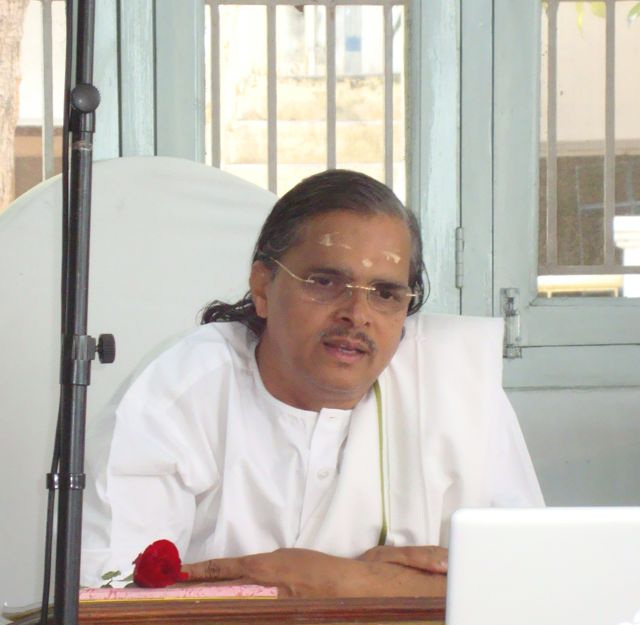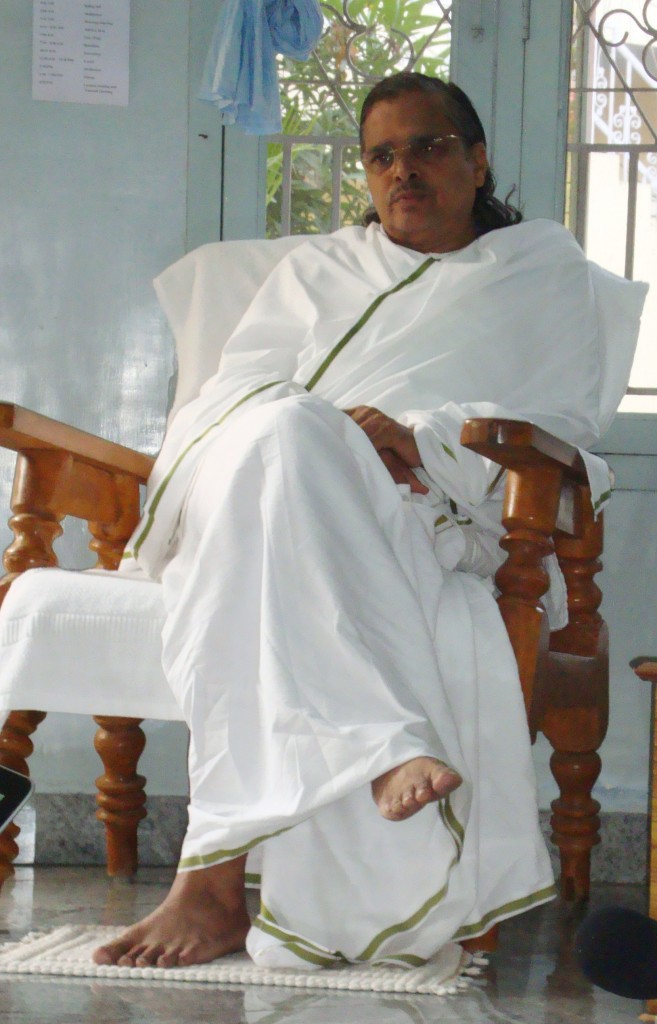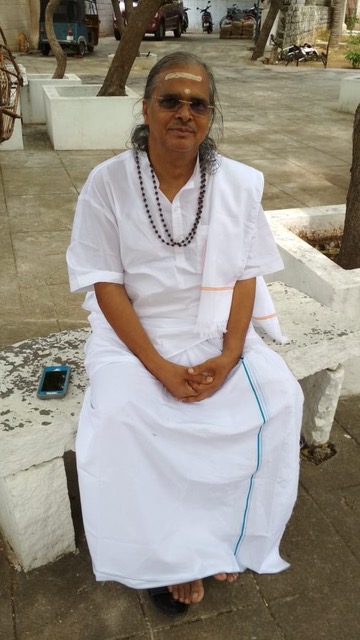Omm Namo Bhagavate

Excerpt from a 2012 workshop regarding the concepts of attachment and discrimination in Chapter 2 of the Bhagavad Gita.

Omm Namo Bhagavate

Excerpt from a 2012 workshop regarding the concepts of attachment and discrimination in Chapter 2 of the Bhagavad Gita.

Omm Namo Bhagavate
[This Interaction came after a discourse from a visiting Swami, who conveyed with joy and delight the perspective of the traditional yoga path of renunciation. After that, Swami Sri Atmananda said he would share the following, “Not to contradict anything Swamiji has said, because Swamiji represents a tradition which is honored in India from the Vedic time. After listening to him, I just feel to say a few words about the path we are following.”]
The traditional path of yoga emphasizes how this karmic world is a place of sorrow and misery, and the best sadhana we can do is find out how to get out of it. The Gita as we have understood gives us a different message. Although both paths justify their stance by quoting from the Gita, we see it from a different angle than the other paths.
Verse 371 is often quoted by those who follow the path of renunciation, or sänkhya. It says that you have come to this earthly plane, which is transitory and full of sorrow: “Therefore, Arjuna, you should always pray to Me.” The whole teaching of Gita is to show Arjuna, who represents all human beings, the path to quickly enter into Him who is the essence the whole creation.
When Krishna says, “Because you have come to this transitory, unhappy world,” he does not say to escape from here. Krishna always says, “You have entered into the misery of this transitory existence, Arjuna. Therefore enter into Me.” Thus it is not an issue of how soon we get out of this world but how soon we get into it. That refers not to this projected world, which is continuously changing, and not this shadow, which is the reflection of the reality, but to the reality itself: how soon we can enter into it. That is, how soon can we enter into the consciousness of Krishna.
Krishna is in this this transitory world. The very first verse of the Vishnu Sahasranam says, vishwam vishnu, Vishnu is inside this this universe: present everywhere but found nowhere. Our problem is how to find Him. When we do, we can merge in Him, and after that we can manifest Him. The secret is this Vishnu who is inside this creation. He has to be found through the act of invocation. That is why Vishnu Sahasranam begins by stating that through the act of invocation, we can find this Vishnu, the Creator Himself. Where? Krishna says, “Arjuna, you can find Me everywhere and anywhere.” In the tenth chapter He says, “Whatever is glorious, excellent, beautiful, admirable, or commendable, that is I.” If you cannot find Him in that way, then there is a simple method as expressed in Verse 411: “This whole manifest creation is just a portion of me.” That means the magnitude of the eternal consciousness is bigger than this creation, and bigger than the imagination of the human mind. He is so big he cannot hide anywhere. This is the approach through which we enter into this yoga.
Krishna has said only one thing: “Arjuna, attain Me. I am everything. Anything you can think, see, conceive or feel—everything is I. Attain me.”
If all is He, the Lord, then one may wonder why the Lord himself said in several places in Gita that certain things are transitory and not real. It may seem like a contradiction. This question puzzled me for many years, until I found that He has never contradicted Himself. He says, “I am both the unmanifest and the manifest. As manifest I am the maya; as the unmanifest I am the reality. What is seen in the outer universe is a reflection of the reality, so Arjuna, quickly attain me, the reality. The most direct way is by simply loving me. With the love of your heart, you can find Me, enter into Me, and you can be I in that form.”
This is the reason the twelfth chapter, The Yoga of Devotion, is the crest jewel in the garland of Gita. Here Lord Krishna explains, ‘Simply by pure love you can find Me, recognize Me, enter into Me, mingle in Me, and manifest Me. As you are searching for Me in every form, but not getting Me in any form, a time should come—and it must come in this life itself—when I will manifest through you, and all the forms of this creation should be able to recognize that.’
When Krishna is repeatedly telling Arjuna, “Attain Me, worship Me, think of Me and meditate on Me,” this “Me” is not the manifest form. It is the unmanifest force. How can we attain, find, mingle in, recognize and manifest that force if we constantly pray to the Lord to take us away from this transitory and unhappy world? To find the force, be one with the force, wither away in it and ultimately manifest it, we have to retain our bodily form, and thus we have to take care of it. To do that, we enter into this play of prakriti. We must learn the rules of the play so that prakriti will not trap, veil and bind us.
This prakriti is the Lord himself. As manifest He is known as the maya; as unmanifest He is known as the Supreme. We have to find the approach to enter into Him without running away from Him. Krishna repeatedly urges, “Arjuna, before you become crippled, attain Me. Don’t wither away in Me. That’s not the purpose for you taking up so much pain as am embodied being. For several lifetimes you have come and gone just for this one purpose. Once you attain Me, I will manifest through you.” That’s the central message of Gita.
Krishna has shown eighteen techniques to attain Him. One is through extreme sorrow, if you have the strength to endure your torture. That’s why the sorrow, dejection or despondency of Arjuna became the entry point to yoga in Chapter One. When we experience sorrow, hardship or difficulty, we pray to God. Great devotees have even prayed to the Lord to give them sorrow and problems, because they know that those situations link us with the Creator, whereas affluence, abundance, happiness and enjoyment take us away from God.
Another technique is to pray to God for pure philosophy. This is the sänkhya path. Sänkhya says that prakriti derives all power from purusha. Prakriti has no power by herself, but the purusha wrongly thinks that prakriti is the mistress and he is the slave. Sänkhya constantly reminds a seeker that you are purusha, the real source of power; prakriti is only deriving power through you, so get back your sovereignty.
Gita rejects this. In Verse 86, Krishna says, ‘What you just heard is from the angle of sänkhya. Now I will speak from the angle of buddhi yoga, the yoga of intellect. Prakriti has no power; she derives all her power from purusha, but prakriti has been powerful for many births. Scripture says it is 8.4 million births, while the purusha has been powerless. Don’t think that you can now make her powerless in a single birth; don’t waste time on that, Arjuna. Just because you now know that you are the source of power and you ask prakriti to give it back, she will not listen to you. Rather she will declare war against you, smash you and throw you. Then you will again have to come back and this awareness will be gone.’
Lord Krishna continues, ‘Listen to Me. I am showing you the intelligent way to get back your power without challenging prakriti. Prakriti is attached to purusha; purusha is attracted to prakriti. Prakriti has only this one weakness: because she is attached to purusha, whatever this purusha is asking for, she provides. Therefore, apply your intelligence. Don’t challenge her; she is mightier than you—the crippled, blinded purusha, who are devoid of all your awareness and strength. She is the mother. Be the intelligent child. The first priority is, don’t be attracted to her at all. Don’t create curiosity in her. Allow her to do whatever she wants to do. Never ask anything, because that is action. Action always brings result, and through the result prakriti will bind you. Next, never react to her, because reaction will make prakriti angry and she will smash you.’
Verse 511 says the purusha should deal with prakriti in five different ways. First, remaining very close to prakriti, this purusha should always be a calm witness, never even whispering, “Why are you doing what you are doing?” When this is achieved, one obstacle is gone. Not only do you become the witness. Next, you also give your consent to prakriti for whatever she wants to do. If she wants to smash you, allow her. Then if you become a real consenter and are not raising any objections, a second hurdle is gone. There is a third hurdle, as the supporter. Whenever you feel prakriti does not have enough strength, you give yours. “My beautiful, loving mother, can I assist you, or do anything for you? You want to trap me—okay, here is the rope.” Become the supporter of prakriti and the third hurdle is gone.
Next, become the enjoyer without raising any questions. Whatever result she gives, accept it. The last verse of the fifth chapter says that if you want to become the Supreme Lord of all the worlds you have to be the enjoyer of what prakriti is giving to you. You cannot choose. If you do, you cannot become the Lord of prakriti. When you become the silent enjoyer, the fourth hurdle is gone. If all four obstacles are overcome, then prakriti will see that you have overpowered her, not once but four times. She will come and completely surrender before you, and you will become the great Lord of prakriti within you.
Here is a very small example. Look at your own life. I am becoming a close witness to what you are doing, never objecting or challenging. I know what rubbish thing you are going to do, or what rubbish you are talking about me, but I never ask why you do what you are doing. Next, I’m giving consent: “If she is doing that then let her do it. That’s fine.” Then I’m giving you the strength to do it and I am also calmly enduring the result of your actions. Due to these four, you are surrendered to me. Look at your life and you will see. This is the reason; this is the secret.
If this is possible through a formal relationship, imagine what will happen if you apply this as a yogic technique: you are the great Lord and the prakriti within you will surrender to you, and then you will become supreme Self.
The purusha inside this body is verily the Supreme Purusha that has been completely attracted to prakriti’s attributes: her strength, beauty, knowledge and talent. Anything that you can think, imagine, comprehend, feel—everything is prakriti. Purusha is completely free from all these attributes. If you still are not clear, read the seventh and tenth chapters of Gita.
When you stop being attracted to prakriti, you are overcoming prakriti. When this is fully achieved, then this prakriti—who as Yogamaya was the cause of your bondage and your veiling—will take the role of Mahamaya. Then she, the Mother, will work to manifest you, the Supreme Purusha.
Krishna taught this secret technique to Arjuna. How Arjuna can go beyond each of his attractions and attachments is the yoga of Gita. When Arjuna overcomes everything, then he finally says to Krishna, the Lord of yoga and the Supreme Purusha, “Lord, my attachment is gone; I have gotten back my awareness.” By recovering that awareness, Arjuna gained what Krishna told him at the beginning of the fourth chapter: “You and I both have passed through many births. You are Nara; I am Narayan. In every transition we have come. You are forgetting because you are coming through prakriti’s law, but I am remembering because I come due to my law.” When Arjuna got that awareness back, it was a rebirth in consciousness, the rebirth without physically dying. He realized that he was no longer bound by prakriti’s law, and then he said, “Now I shall do as directed by Thee.”
Is Arjuna now prakriti or purusha? That’s the million-dollar question. Krishna is the Supreme Purusha; Arjuna is definitely not the bonded purusha or the witnessing purusha. So is he the prakriti, Yogamaya, Mahamaya—which form is he now? The mission of the incarnation must wait until the collaborator is ready. Arjuna has now become the collaborator, and it is Mahamaya, not Yogamaya, that collaborates with the Supreme for manifestation. Arjuna is now the pure embodiment of Mahamaya, the Supreme Prakriti. With the help of the Supreme Prakriti, the Supreme Purusha will reestablish dharma.
The message of Gita to us is, don’t be fed up with this world of transitory existence. Don’t be identified with this realm of sorrow and misery. Accomplish the mission of your life. The opportunity has come to you after 8.4 million births. After getting this human body, finding the path, knowing the secret, having all the physical strength to do yoga, and receiving the beautiful environment for perfection in yoga, if you cannot accomplish this mission, then the second option is better: get away from this. Get out of this world of sorrow, misery and transitory existence and attain the bliss. There are only these two ways. No third option.
Each chapter of Gita shows us one exit point. Through sorrow or through discrimination; if not discrimination, then through action; if not action, then through knowledge; if not knowledge then through inner renunciation; if not inner renunciation, then through meditation; if not meditation, then through the process of knowing the Self and the Supreme; if not that, then through devotion. It goes on and on. God has shown so many paths to run away from the clutches of His maya, but He has shown only one way to find Him, merge in Him and manifest Him before your hair turns gray—that is the state of becoming liberated while living. Traditional yoga will say that after leaving the body you can go to this or that plane, but what’s the guarantee that you will definitely go to these theoretical destinations? Alternatively, Gita says very clearly that verily when you are in the body—not after leaving the body—you can manifest Me, the Supreme Consciousness.
In Verse 84, Krishna told Arjuna, “If you win, you will enjoy the earth.” If you attain supreme consciousness, you become another Krishna in a form, and you will enjoy everything that the whole earth has to give. Whereas in the traditional path, if you are dead to passion, lust, greed, and anger, then in this life itself you will enjoy unending happiness and bliss. But you have to be dead. If you want to live and really experience everything, like Krishna experiencing everything, there is another way. With Lord Krishna’s grace, we are aspiring to reach dynamic delight, so that we sing and dance and eat and sleep and do everything, but get contaminated with nothing.
[From May 2010 Interaction at Satyachetana Ashram, Tiruvannamalai, India.]

Omm Namo Bhagavate
From a September 2012 Interaction at Satyachetana Ashram, Tiruvannamalai, India. 11 minutes.